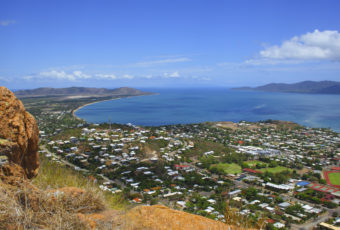Bond researchers develop new surf rating system
A new surf safety rating system developed by researchers at Bond University is set to be implemented across all surf lifesaving surfboat events after helping to reduce serious head-related injuries.
The Surf Hazard Rating (SHR) model was designed by Bond Faculty of Business academics, Gary McCoy and Neville de Mestre, to assess surf conditions in real-time based on seven surf zone characteristics, acting as a tool to help surf lifesaving decision-makers identify when to mandate wearing safety helmets.

Under the system, injury-rate data was collected from 47 surfboat carnivals throughout mainland Australia during the 2014/15 season. Across the 1603 events, only 25 injuries were recorded and, of these, only 6 were considered serious.
Mr McCoy said, under the model, it was mandatory for surfboat competitors to wear helmets when the SHR reached a threshold value of 13, on a scale of 1 to 30+.
“The trial found significant evidence that the serious nature of head-related injuries was reduced overall because competitors were wearing helmets at the time of any accidents,” said Mr McCoy.
“Based on its success, we are now working with SLSA to undertake similar research for surf craft events this season, where an appropriate threshold will be implemented for the use of floatation vests.
“The model is also already being used in an informal way to help make risk-related judgements on whether to continue, postpone, cancel or transfer individual or whole carnival events, and we hope to work on formalising this process as well.”
The research, funded by Surf Life Saving Australia, began in the wake of a fatal incident at the Australian Surf Life Saving Championships in 2012, following similar drowning incidents at championship events in 2010 and 1996.
Mr McCoy said, under the SHR, surf helmets had been worn in about 30 per cent of surfboat events during the season.
“There were a number of serious injuries that were avoided using this tool,” he said.
“The rating system has regularly assisted referees in making the correct call on the day. The feedback across the board from both officials and competitors has been extremely positive.”
Mr McCoy said the SHR was an alternative to the ‘one metre rule,’ which was previously used by SLSA. Under the rule, as soon as the wave height reached one metre, surf helmets had to be worn.
“The one metre rule does not take into account many other factors, including whether the water is glassy or choppy, the wave period is long or short, the width of the surf zone and so forth,” he said.
“Up until now there has been no easily observable and measurable surf rating system available that covers the relevant hazards in the surf zone.”
Mr McCoy said that over fifty referees had been trained to use the SHR system this season.
“They regularly reassess the surf conditions throughout the day using this tool and make decisions accordingly,” he said.
“Our research found both officials and competitors felt very comfortable with those decisions.
“There has been an enormous effort made over nearly three years now to develop this system, both by the Bond research team and the SLSA membership, and we look forward to extending this into more events over the coming season.”
Mr McCoy said the model had future potential to give ‘individualised’ assessments of the ‘heightened risk’ when entering the surf environment, using each person’s “Surf Competency Rating” called the “Surf Safety Index.”
“This is one of the most exciting parts of the project because it might eventually be used to inform the general public in the form of an individualised profile regarding surf safety,” he said.
Actuarial Science at Bond University Business School
Actuaries are business professionals who combine the elements of economics, finance, statistics and advanced mathematics to interpret, manage and evaluate risk. The Master of Actuarial Science is an innovative and immersive program that combines advanced mathematics, statistics, data analytics, actuarial risk theory, finance, economics and accounting subjects with large-scale, real-life commercial data analysis.
The Master of Actuarial Science will prepare students for rewarding careers in a range of disciplines, including climatology, finance, health, insurance, research, safety, science and technology.
Program: Master of Actuarial Science
Location: Gold Coast, Queensland
Duration: 1.3 years (4 semesters)
Semester intake: September 2015
Apply to Bond University Business School!
*

































Ask A Question
Ask us about your program of interest, or if you have a question about our services.
CONTACT US TODAY